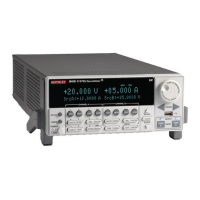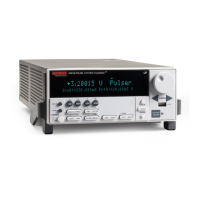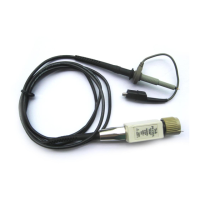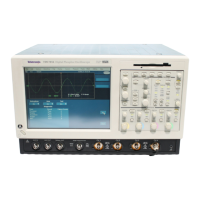This register set feeds to bit B7 (OSB) of the Status Byte. The bits used in the Operation Status
Register set are described as follows:
• Bit B0, Calibrating (CAL): Set bit indicates that one or more channels are calibrating.
• Bit B3, Sweeping (SWE): Set bit indicates that one or more channels are sweeping.
• Bit B4, Measuring (MEAS): Bit is set when making an overlapped measurement, but it is not set
when making a normal synchronous measurement.
• Bit B10, Trigger Overrun (TRGOVR): Set bit indicates that an enabled bit in the Operation
Status Trigger Overrun Summary Register is set.
• Bit B11, Remote Summary (REM): Set bit indicates that an enabled bit in the Operation Status
Remote Summary Register is set.
• Bit B12, User (USER): Set bit indicates that an enabled bit in the Operation Status User Register
is set.
• Bit B13, Instrument Summary (INST): Set bit indicates that an enabled bit in the Operation
Status Instrument Summary Register is set.
• Bit B14, Program Running (PROG): Set bit indicates that a program is running.
For more information on the Operation Status Registers, refer to Status register set contents (on
page 12-1) and the figures in this section.
Questionable Status Registers
This register set feeds to bit B3 (QSB) of the Status Byte. The bits used in the Questionable Status
Register set are described as follows:
• Bit B8, Calibration (CAL): Set bit indicates that calibration is questionable.
• Bit B9, Unstable Output (UO): Set bit indicates that an unstable output condition was detected.
• Bit B12, Over Temperature (OTEMP): Set bit indicates that an over temperature condition
was detected.
• Bit B13, Instrument Summary (INST): Set bit indicates that a bit in the Questionable Status
Instrument Summary Register is set.
Questionable Status Registers
As shown in the Operation event, I/O, and TSP-Link registers (on page 12-11) of the status model,
there are seven register sets associated with Questionable Status. Commands are summarized in
Status byte and service request (SRQ) (on page 12-15). You can also set bits by using numeric
parameter values. For details, see Programming enable and transition registers (on page 12-14).
For example, either of the following commands sets the CAL enable bit (B8):
status.questionable.enable = status.questionable.CAL
status.questionable.enable = 256
